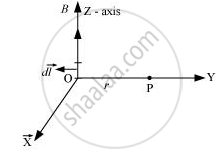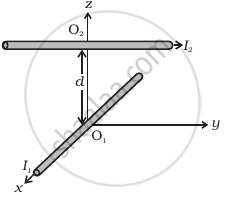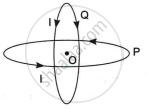Advertisements
Advertisements
प्रश्न
Express Biot – Savart law in the vector form.
उत्तर
Consider a straight infinnitely long wire carrying a steady current I. Point P is the perpenicular distance from the wire. Consider a small element dl of the wire at the point O on the wire. The line joining points O to P( OP = vector r ) makes an angle θ with the direction of the current element dl.

`dvecB = (μ_oI)/(4π) (vec(dl) xx vec r)/r^3`
The expression for the total magnetic field B due to the wire can be obtained by intergrating the above expression as
`vecB =∫(μ_oI)/(4π) (vec(dl)xxvecr)/r^3`
It is the biot savart law which gives the magnetic field B generated by steady electric current I when the current can be approximated as running through an infinitely running wire.
संबंधित प्रश्न
State Biot-Savart law.
A current I flows in a conductor placed perpendicular to the plane of the paper. Indicate the direction of the magnetic field due to a small element d `vecl` at point P situated at distance `vecr` from the element as shown in the figure.

An alpha particle is projected vertically upward with a speed of 3.0 × 104 km s−1 in a region where a magnetic field of magnitude 1.0 T exists in the direction south to north. Find the magnetic force that acts on the α-particle.
A regular polygon of n sides is formed by bending a wire of total length 2πr which carries a current i. (a) Find the magnetic filed B at the centre of the polygon. (b) By letting n → ∞, deduce the expression for the magnetic field at the centre of a circular current.
State Biot Savart law.
State and explain the law used to determine the magnetic field at a point due to a current element. Derive the expression for the magnetic field due to a circular current-carrying loop of radius r at its center.
Two concentric circular loops of radius 1 cm and 20 cm are placed coaxially.
(i) Find mutual inductance of the arrangement.
(ii) If the current passed through the outer loop is changed at a rate of 5 A/ms, find the emf induced in the inner loop. Assume the magnetic field on the inner loop to be uniform.
- both are long range and inversely proportional to the square of distance from the source to the point of interest.
-
both are linear in source.
-
both are produced by scalar sources.
-
both follow principle of superposition.
A circular loop of radius 0.3 cm lies parallel to much bigger circular of radius 20 cm. The centre of the small loop is on the axis of the bigger loop. The distance between their centres is 15 cm. If a current of 2.0 A flows through the smaller loop, then the flux linked with the bigger loop is ______.
Two long wires carrying current I1 and I2 are arranged as shown in figure. The one carrying current I1 is along is the x-axis. The other carrying current I2 is along a line parallel to the y-axis given by x = 0 and z = d. Find the force exerted at O2 because of the wire along the x-axis.

Two identical circular loops P and Q, each of radius R carrying current I are kept in perpendicular planes such that they have a common centre O as shown in the figure.

Find the magnitude and direction of the net magnetic field at point O.
